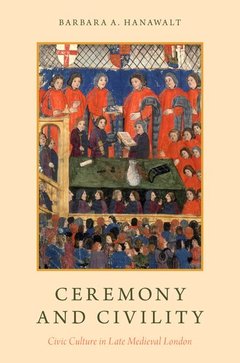Ceremony and Civility Civic Culture in Late Medieval London
Langue : Anglais
Auteur : Hanawalt Barbara A.

In Ceremony and Civility, Barbara Hanawalt shows how, in the late Middle Ages, London's elected officials and elites used ceremony and ritual to establish their legitimacy and power. These civic ceremonies helped delineate the relationship between London's mayors and the crown, but also between denizens and their government, between gild wardens and their members, between masters and apprentices, and between parishioners and their churches. London, like all premodern cities, had a largely immigrant population--only a small proportion of the inhabitants were citizens--and the newly arrived needed to be taught the civic culture of the city in order for that city to function peacefully. Ritual and ceremony played key roles in this acculturation process. In a society in which hierarchical authority was most commonly determined by inheritance of title and office, or sanctified by ordination, civic officials who had been elected to their posts relied on rituals to cement their authority, power, and dominance. Since the typical term of elected office was a year, elections and inaugurations had to be very public and visually distinct in order to quickly communicate with the masses: the robes of office needed to distinguish the officers so that everyone would know who they were. The result was a colorful civic pageantry. Newcomers themselves found their places within this structure in various ways. Apprentices entering the city to take up a trade were educated in civic culture by their masters. Gilds similarly used rituals, oath swearing, and distinctive livery to mark their members' belonging. But these public shows of belonging and orderly civic life also had a dark side. Those who rebelled against authority and broke the civic ordinances were made spectacles through ritual humiliations and public parades through the streets so that others could take heed of these offenders of the law. At the parish level, and even at the level of the street, civic behavior was taught through example, through proclamations, and even through performances, like ballads. An accessible look at late medieval London through the lens of civic ceremonies and dispute resolution, Ceremony and Civility synthesizes archival research in London with existing scholarship to show how newcomers in an ever-shifting population were enculturated into premodern London.
Barbara A. Hanawalt is King George III Professor of British History Emerita, Ohio State University. Her books include The Ties That Bound: Peasant Families in Medieval England (1986); Growing Up in Medieval London: The Experience of Childhood in History (1993); Of Good and Ill Repute: Gender and Social Control in Medieval England (1999); and The Wealth of Wives: Women, Law, and the Economy in Late Medieval London (2007).
Date de parution : 08-2017
Ouvrage de 248 p.
23.1x15.5 cm
Disponible chez l'éditeur (délai d'approvisionnement : 21 jours).
Prix indicatif 37,41 €
Ajouter au panierDate de parution : 09-2017
Ouvrage de 248 p.
23.9x16 cm
Disponible chez l'éditeur (délai d'approvisionnement : 21 jours).
Prix indicatif 140,09 €
Ajouter au panier
© 2024 LAVOISIER S.A.S.



